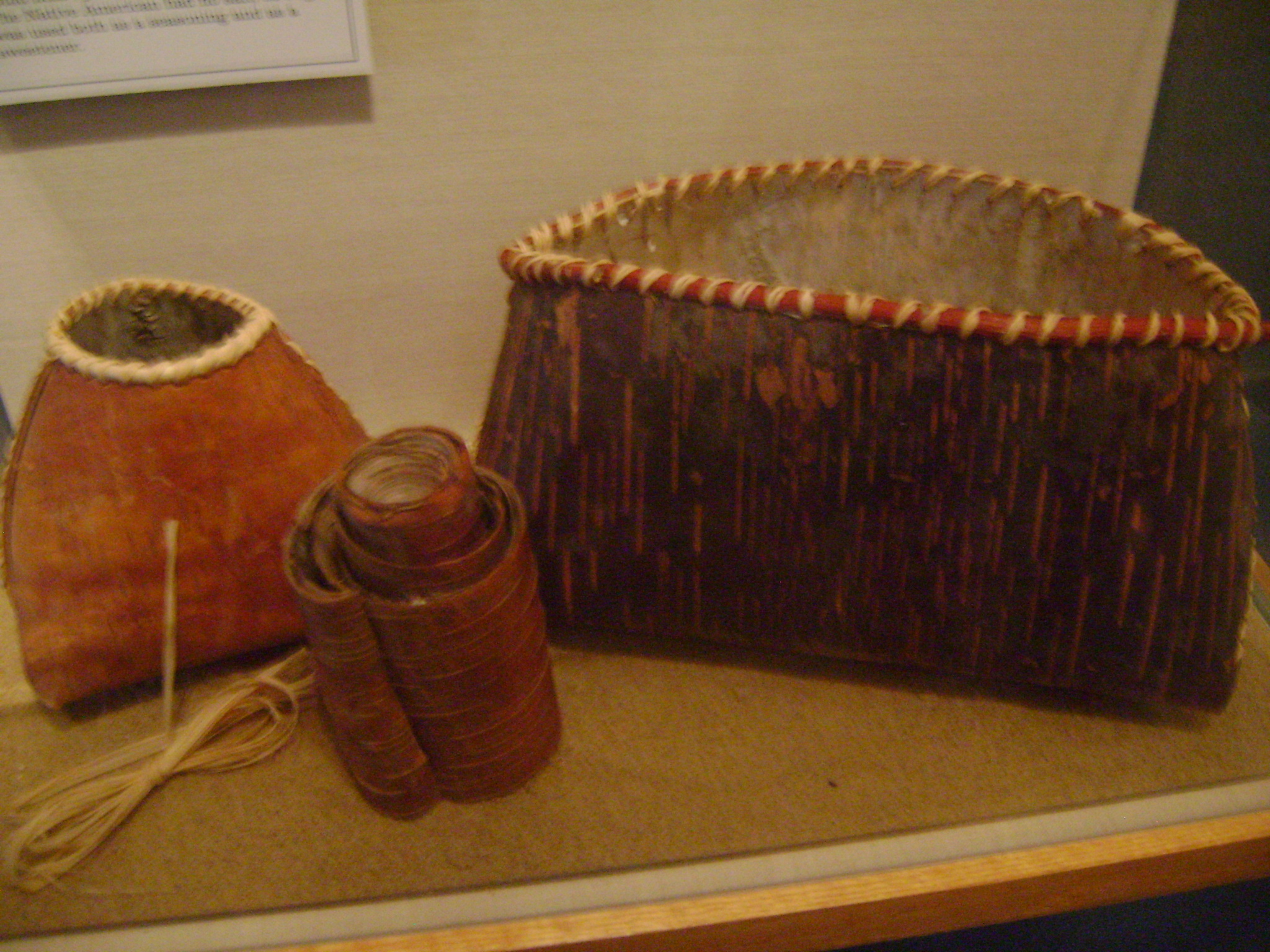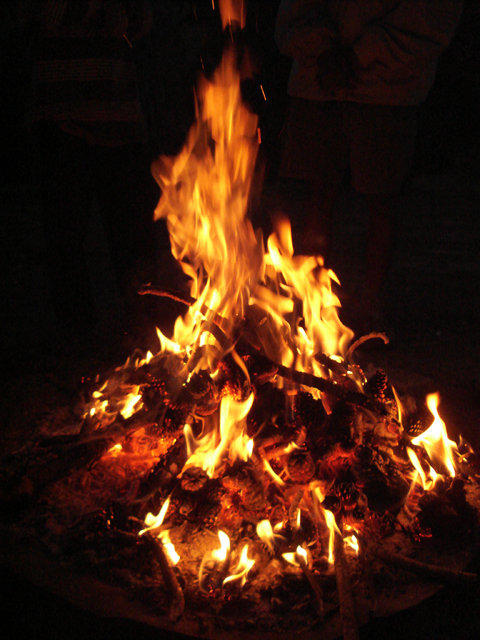|
Wiigwaasi-makak
A wiigwaasi-makak (plural: ''wiigwaasi-makakoon''), meaning "birch-bark box" in the Anishinaabe language, is a box made of panels of birchbark sewn together with watap. The construction of ''makakoon'' from birchbark was an essential element in the culture of the Anishinaabe people and other members of the Native Americans and First Nations of the Upper Great Lakes, particularly in the regions surrounding Lake Superior. Birchbark ''makakoon'' continue to be crafted to this day as heritage heirlooms and for the tourist trade. Lake Superior-area geology is short in supplies of clay, making pottery scarce for the people who lived there. However, the paper birch grows in profusion in this area, and sheets and panels of its strong, papery bark can be cut and carved from a tree for use. Birchbark boxes played a key role in creating durable packages and utensils for storage and everyday use. Skilled harvesting of the bark, done at the proper season of the year, does not fatall ... [...More Info...] [...Related Items...] OR: [Wikipedia] [Google] [Baidu] |
Maple Sugar
Maple sugar is a traditional sweetener in Canada and the Northeastern United States, prepared from the sap of the maple tree ("maple syrup, maple sap"). Sources Three species of maple trees in the genus ''Acer (plant), Acer'' are predominantly used to produce maple sugar: the Acer saccharum, sugar maple (''A. saccharum''), the Acer nigrum, black maple (''A. nigrum''), and the Acer rubrum, red maple (''A. rubrum''), because of the high sugar content (roughly two to five percent) in the sap of these species. The black maple is included as a subspecies or variety (botany), variety in a more broadly viewed concept of ''A. saccharum'', the sugar maple, by some botanists. Of these, the red maple has a shorter season because it buds earlier than sugar and black maples, which alters the flavor of the sap. A few other species of maple are also sometimes used as sources of sap for producing maple sugar, including the Acer negundo, box elder (or Manitoba maple, ''A. negundo''), the A ... [...More Info...] [...Related Items...] OR: [Wikipedia] [Google] [Baidu] |
Birchbark
Birch bark or birchbark is the bark of several Eurasian and North American birch trees of the genus ''Betula''. For all practical purposes, birch bark's main layers are the outer dense layer, white on the outside, and the inner porous layer (cambium). For vast majority of crafts, the outer bark is used. In many languages it has a separate name. For example, in Russian "birch bark" is "beryozovaya kora", while the outer birch bark is "beryosta". The strong and water-resistant cardboard-like outer bark can be easily cut, bent, and sewn, which has made it a valuable building, crafting, and writing material, since pre-historic times. Today, birch bark remains a popular type of wood for various handicrafts and arts. Birch bark also contains substances of medicinal and chemical interest. Some of those products (such as betulin) also have fungicidal properties that help preserve bark artifacts, as well as food preserved in bark containers. Collection and storage Removing birch ... [...More Info...] [...Related Items...] OR: [Wikipedia] [Google] [Baidu] |
Watap
Watap, watape, wattap, or wadab ( or ) is the thread and cordage used by the Native Americans and First Nations peoples of Canada to sew together sheets and panels of birchbark. The word itself comes from the Algonquian language family, but watap cordage was used and sewn by all of the people who lived where the paper birch tree grows. The cordage was usually manufactured from the roots of various species of conifers, such as the white spruce, black spruce, or Northern whitecedar, but could originate from a variety of species that sprouted root fibers with sufficient tensile strength for the required purpose. In a typical manufacturing process, the roots would be debarked, subjected to a lengthy soaking process, and then steamed or boiled to render them pliable for sewing. The roots could be left whole and used as cords, or divided into smaller fibers for twine.Willow, Anna J. Winter 2010. Cultivating Common Ground: Cultural Revitalization in Anishinaabe and Anthrop ... [...More Info...] [...Related Items...] OR: [Wikipedia] [Google] [Baidu] |
Quillwork
Quillwork is a form of textile embellishment traditionally practiced by Indigenous peoples of the Americas, Indigenous peoples of North America that employs the Spine (zoology), quills of porcupines as an aesthetic element. Quills from bird feathers were also occasionally used in quillwork. History Porcupine quillwork is an art form unique to North America. Before the introduction of glass beads, quillwork was a major decorative element used by the peoples who resided in the porcupine's natural habitat,Gillow and Sentance 223 which included indigenous peoples of the Subarctic, indigenous peoples of the Northeastern Woodlands, Northeastern Woodlands, and Northern Plains. The use of quills in designs spans from Maine to Alaska.Orchard Quillworking tools were discovered in Alberta, Canada and date back to the 6th century CE. Cheyenne oral history, as told by Picking Bones Woman to George Bird Grinnell, says quilling came to their tribe from a man who married a woman, who hid her tru ... [...More Info...] [...Related Items...] OR: [Wikipedia] [Google] [Baidu] |
Native American Relics
Native may refer to: People * '' Jus sanguinis'', nationality by blood * '' Jus soli'', nationality by location of birth * Indigenous peoples, peoples with a set of specific rights based on their historical ties to a particular territory ** Native Americans (other) In arts and entertainment * Native (band), a French R&B band * Native (comics), a character in the X-Men comics universe * ''Native'' (album), a 2013 album by OneRepublic * ''Native'' (2016 film), a British science fiction film * ''The Native'', a Nigerian music magazine In science * Native (computing), software or data formats supported by a certain system * Native language, the language(s) a person has learned from birth * Native metal, any metal that is found in its metallic form, either pure or as an alloy, in nature * Native species, a species whose presence in a region is the result of only natural processes * List of Australian plants termed "native", whose common name is of the form "native . . ." ... [...More Info...] [...Related Items...] OR: [Wikipedia] [Google] [Baidu] |
Medicine Bag
A medicine bag is usually a small pouch, worn by some Indigenous peoples of the Americas, that contains sacred items. A personal medicine bag may contain objects that symbolize personal well-being and tribal identity. Traditionally, medicine bags are worn under the clothing. Their contents are private, and often of a personal and religious nature. See also * Medicine man * Midewiwin * Medicine wheel Medicine wheels are petroforms or circular formations of rocks on the land. Historically, most medicine wheels followed a similar pattern of a central circle or cluster of stones, surrounded by an outer ring of stones, along with spokes radiatin ... References Bags Native American religion Religious objects Traditional medicine Amulets Talismans {{NorthAm-native-stub ... [...More Info...] [...Related Items...] OR: [Wikipedia] [Google] [Baidu] |
Porcupine
Porcupines are large rodents with coats of sharp Spine (zoology), spines, or quills, that protect them against predation. The term covers two Family (biology), families of animals: the Old World porcupines of the family Hystricidae, and the New World porcupines of the family Erethizontidae. Both families belong to the infraorder Hystricognathi within the profoundly diverse order (biology), order Rodentia and display superficially similar coats of rigid or semi-rigid quills, which are modified hairs composed of keratin. Despite this, the two groups are distinct from one another and are not closely related to each other within the Hystricognathi. The largest species of porcupine is the third-largest living rodent in the world, after the capybara and beaver. The Old World porcupines (Hystricidae) live in Italy, Asia (western and southern), and most of Africa. They are large, terrestrial, and strictly nocturnal. The New World porcupines (Erethizontidae) are indigenous to North Amer ... [...More Info...] [...Related Items...] OR: [Wikipedia] [Google] [Baidu] |
Spine (zoology)
In a zoological context, spines are hard, needle-like anatomical structures found in both vertebrate and invertebrate species. The spines of most spiny mammals are modified hairs, with a spongy center covered in a thick, hard layer of keratin and a sharp, sometimes barbed tip. Occurrence Mammals Spines in mammals include the prickles of hedgehogs, and among rodents, the quills of porcupines (of both the New World and the Old), as well as the prickly fur of spiny mice, spiny pocket mice, and of species of spiny rat. They are also found on afrotherian tenrecs of the family Tenrecinae (hedgehog and streaked tenrecs), marsupial spiny bandicoots, and on echidnas (a monotreme). An ancient synapsid, ''Dimetrodon'', had extremely long spines on its backbone that were joined together with a web of skin that formed a sail-like structure. Many mammalian species, like cats and fossas, also have penile spines. The Mesozoic eutriconodont mammal '' Spinolestes'' already displa ... [...More Info...] [...Related Items...] OR: [Wikipedia] [Google] [Baidu] |
Combustion
Combustion, or burning, is a high-temperature exothermic redox chemical reaction between a fuel (the reductant) and an oxidant, usually atmospheric oxygen, that produces oxidized, often gaseous products, in a mixture termed as smoke. Combustion does not always result in fire, because a flame is only visible when substances undergoing combustion vaporize, but when it does, a flame is a characteristic indicator of the reaction. While activation energy must be supplied to initiate combustion (e.g., using a lit match to light a fire), the heat from a flame may provide enough energy to make the reaction self-sustaining. The study of combustion is known as combustion science. Combustion is often a complicated sequence of elementary reaction, elementary Radical (chemistry), radical reactions. Solid fuels, such as wood and coal, first undergo endothermic pyrolysis to produce gaseous fuels whose combustion then supplies the heat required to produce more of them. Combustion is often hot e ... [...More Info...] [...Related Items...] OR: [Wikipedia] [Google] [Baidu] |
Boiling Point
The boiling point of a substance is the temperature at which the vapor pressure of a liquid equals the pressure surrounding the liquid and the liquid changes into a vapor. The boiling point of a liquid varies depending upon the surrounding environmental pressure. A liquid in a partial vacuum, i.e., under a lower pressure, has a lower boiling point than when that liquid is at atmospheric pressure. Because of this, water boils at 100°C (or with scientific precision: ) under standard pressure at sea level, but at at altitude. For a given pressure, different liquids will boiling, boil at different temperatures. The normal boiling point (also called the atmospheric boiling point or the atmospheric pressure boiling point) of a liquid is the special case in which the vapor pressure of the liquid equals the defined atmospheric pressure at sea level, one Atmosphere (unit), atmosphere. At that temperature, the vapor pressure of the liquid becomes sufficient to overcome atmospheric pre ... [...More Info...] [...Related Items...] OR: [Wikipedia] [Google] [Baidu] |
Campfire
A campfire is a fire at a campsite that provides light and warmth, and heat for cooking. It can also serve as a beacon, and an insect and predator deterrent. Established campgrounds often provide a stone or steel fire ring for safety. Campfires are a popular feature of camping. At summer camps, the word campfire often refers to an event (ceremony, get together, etc.) at which there is a fire. Some camps refer to the fire itself as a campfire. History First campfire A new analysis of burned antelope bones from caves in Swartkrans, South Africa, confirms that ''Australopithecus robustus'' and/or ''Homo erectus'' built campfires roughly 1.6 million years ago. Nearby evidence within Wonderwerk Cave, at the edge of the Kalahari Desert, has been called the oldest known controlled fire. Microscopic analysis of plant ash and charred bone fragments suggests that materials in the cave were not heated above about . This is consistent with preliminary findings that the fires burned grasses, ... [...More Info...] [...Related Items...] OR: [Wikipedia] [Google] [Baidu] |






